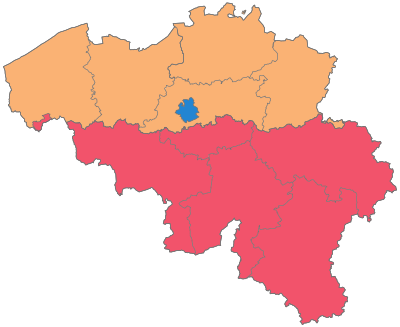
Back Provinsies van België AF مقاطعات بلجيكا Arabic Proviñsoù Belgia BR Belgijske pokrajine BS Províncies de Bèlgica Catalan Belgie#Administrativní rozdělení Czech Politische Gliederung Belgiens German Επαρχίες του Βελγίου Greek Belgaj provincoj EO Provincias de Bélgica Spanish
| Provinces of Belgium Provincies van België (Dutch) Provinces de Belgique (French) Provinzen Belgiens (German) | ||
|---|---|---|
| Category | Decentralised unit in a federal state | |
| Location | ||
| Number | 10 provinces | |
| Populations | 295,146 (Luxembourg) – 1,926,522 (Antwerp) [1] | |
| Areas | 1,097 km2 (424 sq mi) (Walloon Brabant) – 4,459 km2 (1,722 sq mi) (Luxembourg) [2] | |
| Government | ||
| Subdivisions | ||
The Kingdom of Belgium is divided into three regions. Two of these regions, Flanders and Wallonia, are each subdivided into five provinces. The third region, Brussels, does not belong to any province, nor is it subdivided into provinces. Instead, it has amalgamated both regional and provincial functions into a single "Capital Region" administration.
Most of the provinces take their name from earlier duchies and counties of similar location, while their territory is mostly based on the departments installed during French annexation. At the time of the creation of Belgium in 1830, only nine provinces existed, including the province of Brabant, which held the City of Brussels. In 1995, Brabant was split into three areas: Flemish Brabant, which became a part of the region of Flanders; Walloon Brabant, which became part of the region of Wallonia; and the Brussels-Capital Region, which became a third region. These divisions reflected political tensions between the French-speaking Walloons and the Dutch-speaking Flemish; the Brussels-Capital Region is officially bilingual.
The division into provinces is fixed by Article 5 of the Belgian Constitution. The provinces and Brussels are subdivided into 43 administrative arrondissements, and further into 581 municipalities.
- ^ Structure of the Population, STATBEL
- ^ Land use according to the land register, STATBEL
